Scroll from the bottom up to read in chronological order. And click here to catch up on the rest of our coronavirus coverage.
4:34pm: Gilroy fest put to rest—for now.
— Garlic Festival (@GilroyGarlicFes) March 20, 2020
It’s still more than three months out, but organizers for the Gilroy Garlic Festival announced Friday afternoon that there will be no fair this year. In a statement this afternoon, organizers cited the coronavirus as the reason for cancelling the 2020 festival.
“The health and well-being of our community is paramount,” the statement said.
The event will be postponed to July 23 to 25 next year.
—Grace Hase
2:34pm: Spare the air days.
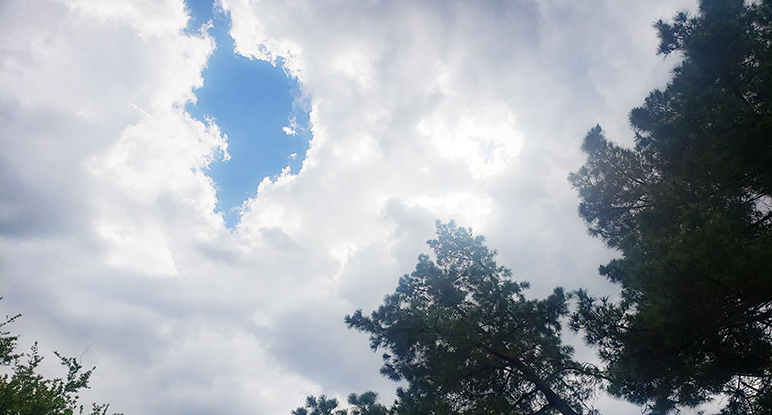
The South Bay skies have been rain-washed and windswept. (Photo by Jennifer Wadsworth)
On March 2, European Society of Cardiology researchers published a study on how dirty air shortens more lives than wars, smoking, parasitic disease and HIV. They said they’re findings suggest that the world faces an air pollution “pandemic.”
Barely two weeks have passed and we’re in the midst of a very different pandemic. Although pollution still poses an existential threat for millions of people each year, the pandemic we’re reckoning with on a global scale through unprecedented isolation has had a measurable effect on air quality in some places.
Satellite imagery of three coronavirus hotspots shows a dramatic decline in air pollution in just the past couple weeks as China, Iran and Italy brought their economies to an abrupt halt. One Stanford University scientist estimated that China’s sweeping lockdown has saved 77,000 lives—about seven times the COVID-19 death rate so far—by curbing emissions from cars and factories.
Amid a statewide stay-at-home mandate to curb the spread of the novel coronavirus, the Bay Area has seen vehicle traffic plummet. Rush hour to and from S.F. is moving 22 percent faster, by some metrics. The air really does feel much cleaner.
But how much these blue skies and crisp air owe to our regional lockdown remains to be seen, according to Kristine Roselius, a spokeswoman for the Bay Area Air Quality Management District (BAAQMD).
“We’ve gotten this question a lot from other reporters and members of the public,” she said. “And the answer right now, at least, is that it’s really hard to tell.”
Rain, winds and unsettled weather of the sort we’ve had lately has improved the air quality lately, so it’s hard to say how much of this owes to the reduction in traffic and urban emissions. The district would need months of data and draw comparisons to prior years to come up with a reliable comparison.
“Now that said, if you take out the largest sources of pollution in the Bay Area—and that would be cars—then there will be reduced pollution levels,” Roselius said. “We did do a back-of-the-envelope calculation and we have some reduction in numbers, but it’s hard to say by exactly how much.”
The other factor in play is that the district would be measuring different types of pollution. That is, fine particulates produced by cars known as PM2.5, carbon dioxide greenhouse gas emissions and nitrogen oxide, which creates smog.
“Let’s say there’s a reduction in traffic by 70 percent,” she said. “Then, we would see a likely drop in pollution—and these are estimates—of 20 percent for PM2.5, about a 38 percent drop for NOx and about 26 percent for Co2.”
With the air district under the same stay-at-home order that’s shut down the entire region, Roselius said they’re running a bare-bones operation. Crunching the numbers to measure the slowdown’s impact on air quality would require the kind of resources that BAAQMD simply doesn’t have right now.
1:45pm: More deaths reported.
Two more people died in Santa Clara County from COVID-19: a man in his 70s and another in his 80s who was hospitalized from March 3 until his passing on Tuesday.
According to the Public Health Department, this brings the local death toll to eight. Also today, the county confirmed seven new COVID-19 cases, which puts the tally at 196.
1:10pm: Help’s on the way.
Companies have raised hundreds of thousands of dollars for respirators, hazmat suits, N-95 masks, surgical gloves and other equipment desperately needed to protect patients, frontline medical workers and first responders amid.
The Silicon Valley Leadership Group (SVLG) is leading the drive for money and supplies, which the Valley Medical Center Foundation will disperse to the nine hospitals that comprise the Santa Clara County healthcare system.
To date, according to the office of county Supervisor Cindy Chavez, more than $531,000 has been donated by Silicon Valley companies and $51,000 from individuals. In-kind donations include: 1,200 respirators and 1,300 surgical masks from Lumileds, 2,000 medical-grade hazmat suits from KLA, 15,000 masks from IBM (which we told you about yesterday—remember?) and 14,000 masks and 4,000 gloves from Western Digital.
Chavez and SVLG CEO Carl Guardino will share more info about the philanthropy drive at a press conference later today. Meanwhile, the Valley Medical Center Foundation will continue accepting money, supplies and services for the county’s pandemic response. To find out how to help, call 408.885.5299, mail a check to 2400 Clove Drive, San Jose 95128, or visit vmcfoundation.org.
12:51pm: Take a hike.
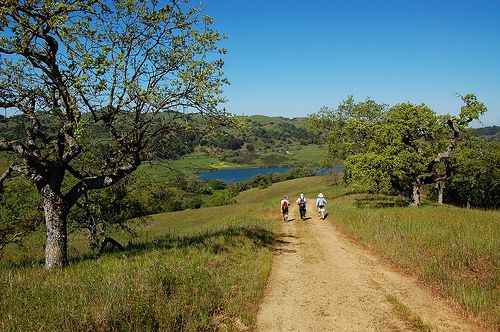
Joseph D. Grant Park in the valley's east hills is one of several throughout the South Bay that's free to enter for as long as we have to abide by this shelter-in-place order. (Photo courtesy of Santa Clara County)
Santa Clara County will waive entrance fees for all its parks for as long as the stay-at-home order remains in effect. You can thank Supervisor Joe Simitian for the latest pandemic perk, which he hopes will encourage people to enjoy the great outdoors—as long as they avoid congregating into groups and keep their distance from other visitors.
“Sometimes in the midst of significant and challenging circumstances, even small things can help,” Simitian wrote to board colleague Mike Wasserman and County Executive Jeff Smith in a memo proposing the waiver. “Folks are coping with a lot right now,” Simitian went on to say. “It just seemed to me that our county should be doing whatever we can, no matter how small, to make people’s lives a little bit easier.”
Click here for a list of county parks and where to find them.
12:23pm: Shelter skelter.
The shelter-in-place order that have grounded millions of Californians gives us a lot of leeway to do what we gotta do. Grocery trips and medical care are allowed, as are walks and hikes. Going over to a friend’s house? Technically, that’s a misdemeanor.
To assuage fears of stop-and-frisk-style enforcement, however, San Jose PD’s advising officers to take it easy. In a March 17 memo to staff, Chief Eddie Garcia explains the rationale: “Considering the broad spectrum of legitimate reasons for which a person may leave residential isolation, it is NOT reasonable to suspect that persons are violating the order merely because they are outside residential isolation.”
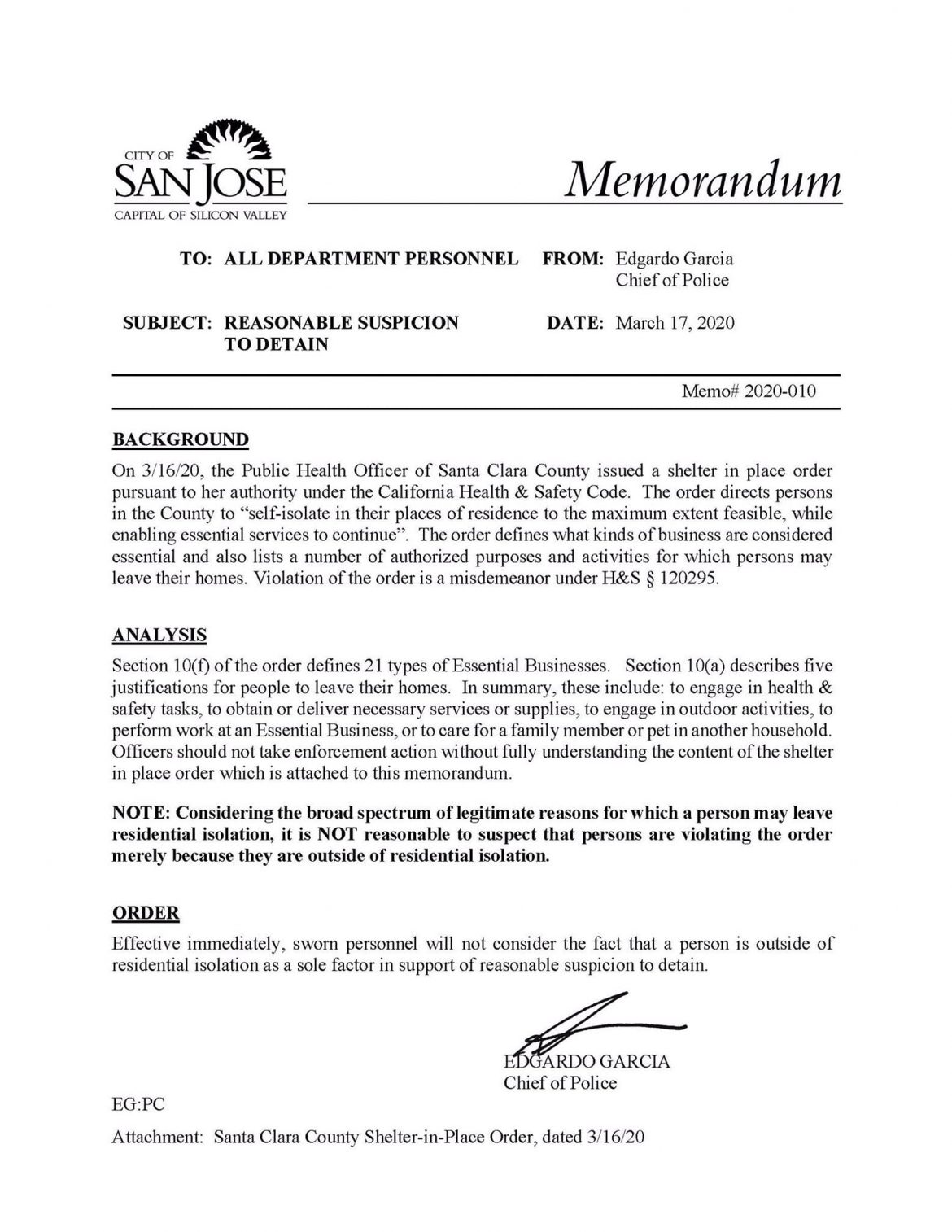
Source: City of San Jose
11:55am: Free for all.
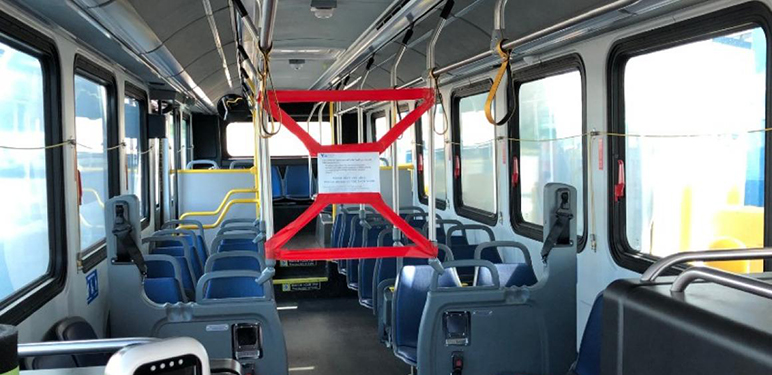
Barriers have been installed in VTA buses to keep drivers a safe distance from everyone else. (Photo via VTA)
VTA is doing its part to “flatten the curve” by requiring passengers to board through the back doors of buses to maintain enough social distancing for drivers. The only people who could use the front door are the ones who need the ramp to embark.
Since it’s more important to protect drivers from COVID-19 exposure, the transit authority says it will cordon them off from the passengers and stop collecting fares on all buses, light rail and paratransit until further notice.
Yup. From now until who-knows-when, the price of passage is on the house.
Additionally, Rapid 500 connecting San Jose’s Diridon Station to the Berryessa Transit Center will be suspended starting Monday. Customers can take routes 64A, 64B or the 68 instead, according to a VTA bulletin about the changes. School trips remain canceled throughout the ongoing lockdown and the VTA will keep analyzing ridership data to determine how to adjust service going forward.
“Like everyone else in this unique situation, with employees on leave or working from home,” the agency warned, “we will experience gaps in service.”
11am: The taxman cometh.
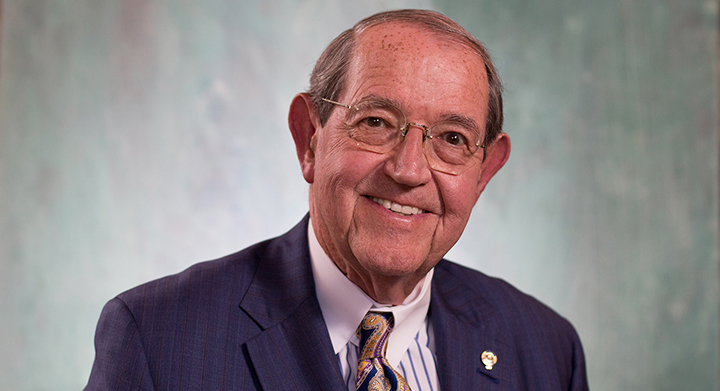
Larry Stone says he's gripped with "a different type of worry" these days.
That old saw about the certainty of death and taxes holds true for property owners—but everyone else gets a little more leeway in paying the government’s cut.
Yes, the pandemic prompted the federal government to give us a grace period on income taxes while the California Franchise Tax Board pushed its own filing deadline for individuals and businesses to July 15. But there’s a little less leeway for property taxes.
Santa Clara County’s due date for property taxes is what it is and it’s still April 10.
That’s not because our local tax collectors are unsympathetic. According to officials who spoke with us about the looming deadline, they just can’t do a damn thing about it.
County Assessor Larry Stone—whose office doesn’t collect taxes but does assay property values to determine what people owe—explained how the mid-April date is enshrined in a state statute that local governments lack the power to change.
“There’s no local discretion,” he says. “So, everybody must pay their taxes by April 10. The only thing that can alter it, I imagine, is action by the legislature.”
With the deadline fast approaching, of course, that’s unlikely to happen. It’s not ideal, but there might be a way around this. Just pay what you can—or nothing at all—and let the county figure out a way to waive the late fees.
Stone says he’s more worried about another deadline. His office has until July 1 to close the assessment roll, which generates $5 billion in property taxes for the county, public schools, special districts and a host of other local government agencies.
“If we don’t get the roll closed with accurate values,” he says, “then the tax bills don’t go out and people don’t pay the bill they don’t receive.”
But the stay-at-home order has emptied out his office, which went from 260 people to just 20 the other day. Though he’s 79 and would work from home if he heeded Gov. Gavin Newsom’s directive for people 65 and up, Stone says he has no choice but to run toward the chaos, which couldn’t have come at a worse possible time. “Our crunch time is from the middle of March to the middle of June,” he says. “That’s when everything happens in my office. That’s why for years we’ve delayed vacations during that timeframe. Everything rests on this, $5 billion rests on us closing the roll by July 1.”
The staffing diaspora has turned things into a “logistical nightmare without any preparation building up to the logistical nightmare,” Stone says. It’ll take a week or two to supply, secure and configure 166 new laptops for employees now working remotely. Instead of hammering away at the constitutionally mandated priorities as assessor, he’s spending three hours a day on conference calls dealing with personnel issues.
Because of his age, which makes him especially vulnerable to the ravages of COVID-19, Stone’s holed up in his office. Like everyone else still working from the county building, he’s avoiding a vacant workstation where one of his appraisers came down with a 103-degree fever on Monday and has since been under quarantine awaiting testing.
“He’s doing OK, but we don’t even know yet what kind of sickness he had,” Stone says. “Now I’m having all the folks he was close to in the real property division wondering whether they were exposed or not and having the janitorial service come in and deep clean his cubicle because nobody wants to go near it.”
While this shakeup is unprecedented in many ways, Stone sees some comparison to the madness that ensued during the Great Recession. When property values suddenly tanked in the late aughts, Stone says it prompted a three-to-fourfold increase in appeals, which forced him to shift resources from the more lucrative work of enrolling new construction and changes of ownership to auditing disputed assessments.
“That’s similar to what we’re doing now,” he adds. “We have to shift resources.”
Hard times have befallen the county before, and Stone anticipates this crisis following a similar trajectory to the one in 2009. “There’s a real connection between the economy, which is going south at the moment, and government revenue, whether that’s income tax or property tax,” he tells me in a phone call. “We’ve been through this before. When the government needs the most money, it’s when things are not going well in the economy and taxpayers’ ability to pay is diminished.”
Stone’s used to worrying, having steered his unit through the best of times and the worst.
“This,” he says, “this is a different type of worry.”
9:43am: Now’s the time for some follow-through.
@elonmusk New York City is buying!
Our country is facing a drastic shortage and we need ventilators ASAP — we will need thousands in this city over the next few weeks. We’re getting them as fast as we can but we could use your help!
We’re reaching out to you directly.
— Mayor Bill de Blasio (@NYCMayor) March 19, 2020
After downplaying the novel coronavirus, calling it “dumb” to panic, claiming its mortality rate was exaggerated and defying a regional shelter-in-place mandate to close the Fremont Tesla factory, Twitter’s problematic fave Elon Musk has finally come around to recognizing the severity of the crisis. Sort of.
While still seeming doubtful about the risk of the virus overwhelming surge capacity of the nation’s hospitals, the Tesla CEO tweeted that he would join General Motors and Ford in making hospital ventilators for COVID-19-sickened patients.
But hey, he said he’d chip in—“if” there’s a shortfall. And since there very much is, it remains to be seen whether he makes good on the offer, which he tweeted to New York Mayor Bill de Blasio, who told CNBC he has yet to hear from the guy.
9:19am: Pay it forward.
The San Jose Peace and Justice Center is crowdsourcing a list of resources for people impacted by this protracted shutdown. Some South Bay-specific efforts include directories for people to add their info if they need help and others for those who can offer it. There’s some guidance for employers and for folks who need testing ... and what a nice surprise! There’s also a link to our live blog. Click here to check it out.
8am: A new ‘new normal.’
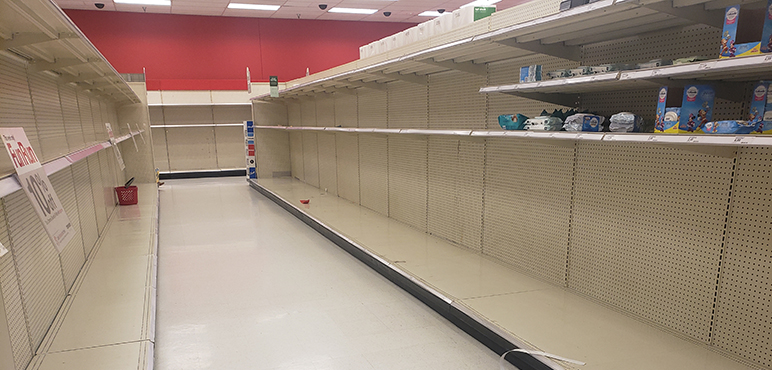
A week before the stay-at-home order spurred a wave of panic-buying, the toilet paper aisles at the Milpitas Target—and many others—were already picked clean. (Photo by Jennifer Wadsworth)
I’m trying to remember when it first hit me.
It wasn’t seeing the shelves cleared of hand sanitizer and TP a couple weeks ago at Milpitas’s Landess Avenue Target. The panic-buying had just begun and people weren’t yet stocking up on all the canned foods and dry goods yet.
I think it dawned on me when I returned home that day figuring I could just find what I needed online only to realize that every single seller out of the coveted germ-killing gel. Except for some overseas Amazon vendor shilling a few-ounce bottle of the stuff for $79 plus a double-digit shipping fee, the only other place to find the clear liquid gold was on Craigslist from a few shady peddlers. (This was before the government declared the outbreak an official emergency, rendering price-gouging criminal).
That, I think, was my first Oh Sh*t moment.
The second came a few days later when COVID-19 canceled SXSW. The third when the NBA suspended its season. The NHL followed suit and so did a Tame Impala concert I planned to attend and seemingly every show and funeral and wedding and vacations of friends and friends of their friends. Tom Hanks got sick with the virus and all those but-the-flu-kills-more-people posts on Facebook became fewer and farther between.
The whole world ground to a halt and every new day became its own uninterrupted Oh Sh*t moment until that became the new “new normal” we’re all talking about. (The old “new normals” being, among other things that now seem like distant memories, the PG&E blackouts, those deadly wildfires, the mass shootings, the commander-in-chief’s warmongering brinksmanship.)
Like every other journalist suddenly thrust onto the pandemic beat, I’ve since written about little else at such a frenetic pace that I still haven’t had a chance to wrap my head around this new reality. Panic subsided to dread that work helped me ignore.
But Thursday brought another one of those moments.
When Gov. Gavin Newsom told us he’s expanding the Bay Area’s shelter-in-place to the whole state, he also admitted there’s no end in sight.
I knew we’d be dealing with the fallout from this crisis for years to come, but the prospect of this physical isolation lasting months and not weeks—that took me off guard. The panic kicked in again. Absent a miracle or massive federal investment, people will lose their jobs, run out of money, grow increasingly desperate. Most Americans barely survive paycheck to paycheck—now they face months on end of this slow-motion disaster?
In the days ahead, my colleagues and I will do our best to figure out what all this means in real time. We’ll be interviewing as many people as possible to bring you stories about how this pandemic will impact our small businesses, our home-bound kids, our starving artists and our pushed-to-the-breaking-point hospital system. We’ll direct you to as many resources as possible to get you through inevitably tough times ahead. We’ll bend an ear to your stories about hardship and resilience.
Listen, it’s not easy for me to write in the first person and I almost cringe at my own earnestness, but I’m stepping outside my comfort zone because I want our readers to feel personally invested in the work we do. This slowdown has hit already struggling newspapers particularly hard, choking off ad revenue from dining and entertainment sectors struggling to survive in their own right, as Grace Hase reported earlier this week.
Please keep in mind that the crises that validate the importance of local journalism also undermine the independent media businesses that make it possible.
As Silicon Valley enters its fourth day of being grounded at home, we’ll be at your service, posting updates right here. So bookmark this page and help us out by sending tips to me at
je*******@me*******.com
or (if you’re sick of me, and I’d understand if you are by now) my colleague Grace Hase at
gh***@me*******.com
.

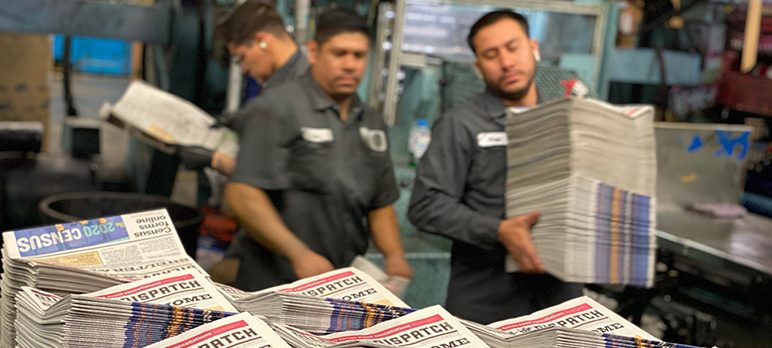
Well Jenifer, I’d say at the very lest your doing a great job of expanding the feeling of panic, Billions of people around the world live in conditions much worse than this every day. Shortages are not the new norm they are the everyday norm.
Barak Obama and Joe Biden tried to convince us this will be the new norm, Burnie Sanders would like this to be the new norm. Bill Maher and CNN and MSDNC have been wishing for just such a disaster “so we can get rid of Trump”!
Well now you have one. Now you get to experience what looks like Socialism from the inside out. Just a tasty bite of what the snake has to offer the brain washed products of a leftwing government run education system.
Well you are all what Joe Stain called “Useful Idiots”. Enjoy your selves. When your down to your last square of TP,
maybe you’ll remember to vote for the guy that came to town to drain the swamp.
I wonder if anyone at GOOGLE or Apple will come up with an app for iPhone toilet paper?
Your comments read like that of a Russian BOT whose purpose is to sow discord, distrust of gov’t, and denigrate others. And you make grammatical errors similar to those of non-native English writers.
Hey Jen and Grace both, I think you’re doing a great job at covering the local news for us. I sincerely appreciate that, and don’t feel bad for going first-person on us. It’s good to know that you’re in it along with the rest of us; we appreciate it.
Also want to say that I do look to SJ Inside for keeping me up to date on what’s happening locally, now and in times not-so-surreal. I do try to support local (and regional investigative) journalism. I do that by subscribing, interacting, talking about it with others. (Aside: I had to cancel my home sub to the SJ Merc a few years ago because they added an arbitration clause to their subscription agreement; SF Chron doesn’t have that in theirs, so now I get the dead tree edition of the Sunday SF news instead).
Thanks for keeping an eye out for us!
This lockdown is over within a month. Americans won’t put with this forever.
Jenn, I think you’re doing a great job. I’m sorry some people are ignorant jerks who will be caught by surprise when someone close to them is in the ICU or dies.
As of March 22 there were 32,356 corona virus case is the US, resulting in 414 deaths. The panic level is mass hysteria, constantly fed by the irresponsible media.
During the Obama years the US had 60.8 MILLION H1N1 cases, resulting in 12,469 deaths. The panic level was chill.
This is the Corona Virus deadly pandemic scam. The virus is deadly without a doubt but those that are dying are the elderly and/or with health problems.
People Die.
Get over it.